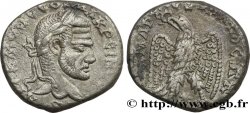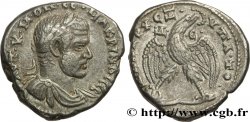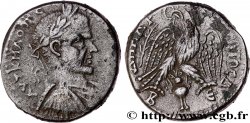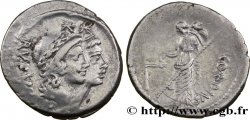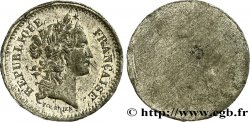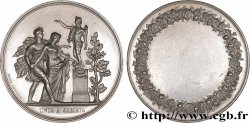bpv_173808 - MACRINUS Tétradrachme syro-phénicien
Not available.
Item sold on our e-shop
Price : 240.00 €
Item sold on our e-shop
Price : 240.00 €
Type : Tétradrachme syro-phénicien
Date: 217-218
Mint name / Town : Byblus, Phénicie
Metal : billon
Diameter : 24 mm
Orientation dies : 6 h.
Weight : 10,30 g.
Rarity : R3
Coments on the condition:
Problèmes de corrosion mais identification indiscutable
Catalogue references :
Obverse
Obverse description : Buste lauré et cuirassé de Macrin à droite, vu de trois quarts en avant, les deux rubans de la couronne laurée descendant derrière la tête (B*).
Obverse legend : AUT K. M. OP. SE. MAKRINOSS, (Autokratoros Kaisaros Markos Opellios Seuhros Makrinos Sebastos)
Obverse translation : (L’empereur césar Marc Opel Sévère Macrin auguste).
Reverse
Reverse description : Aigle debout à droite, les ailes déployées, la tête et la queue tournées à gauche, tenant dans son bec une couronne feuillée ; entre les pattes de l’aigle, un petit autel tricorne au pied large. Dans le champ en haut à droite, une palme.
Reverse legend : DHMARC EX UPATOS PP
Reverse translation : (Revêtu de la puissance tribunitienne consul, père de la patrie).
Commentary
Ce type a été créé depuis la parution du Prieur et se caractérise par un buste seulement cuirassé et une palme au revers dans le champ. L’illustration du Prieur est d’ailleurs erronée et on constate qu’il s’agit du même coin, donc cuirassé seulement. Un exemple d’un véritable 1326 serait l’exemplaire Münz Zentrum 47, n°246 qui est effectivement drapé et cuirassé. Aucune explication satisfaisante n’a été trouvée pour la palme dans le champ.
La série attribuée à Byblos trouve principalement son unité dans ses différents graveurs, spécifiques, la gravure des lettres des légendes, la présence de symboles secondaires dans les champs et bien moins de son symbole, un petit autel. En effet, celui-ci varie de coin en coin et la description des trois pieds et trois cornes dont il serait pourvu est très souvent controuvée par l’observation de la monnaie.
L’attribution à Byblos repose pourtant sur ces particularités de l’autel, que l’on retrouve sur un célèbre bronze de la ville, celui du temple aux obélisques.
Bref, série cohérente, certes, série de Byblos, faute de mieux.
On note que les sigma sont gravés en C.
Dans la base TSP maintenue par Michel Prieur, six exemplaires sont maintenant répertoriés, aucun en musée. Notre exemplaire est le 1326A_002.
This type was created since the publication of the Prior and is characterized by a bust only armored and a palm on the reverse in the field. The illustration of the Prior is also erroneous and we see that it is the same coin, therefore only battleship. An example of a genuine 1326 would be the Münz Zentrum 47, No. 246 example which is indeed draped and cuirassed. No satisfactory explanation has been found for the palm in the field.
The series attributed to Byblos finds its unity mainly in its different, specific engravers, the engraving of the letters of the legends, the presence of secondary symbols in the fields and much less in its symbol, a small altar. In fact, this varies from coin to coin and the description of the three feet and three horns with which it is said to be provided is very often found to be contradictory by observation of the coin..
The attribution to Byblos is based on these particularities of the altar, which can be found on a famous bronze from the city, that of the temple of the obelisks..
In short, a coherent series, certainly, a Byblos series, for want of a better term..
Note that the sigmas are engraved in C.
In the TSP database maintained by Michel Prieur, six examples are now listed, none in museums. Our example is 1326A_002
La série attribuée à Byblos trouve principalement son unité dans ses différents graveurs, spécifiques, la gravure des lettres des légendes, la présence de symboles secondaires dans les champs et bien moins de son symbole, un petit autel. En effet, celui-ci varie de coin en coin et la description des trois pieds et trois cornes dont il serait pourvu est très souvent controuvée par l’observation de la monnaie.
L’attribution à Byblos repose pourtant sur ces particularités de l’autel, que l’on retrouve sur un célèbre bronze de la ville, celui du temple aux obélisques.
Bref, série cohérente, certes, série de Byblos, faute de mieux.
On note que les sigma sont gravés en C.
Dans la base TSP maintenue par Michel Prieur, six exemplaires sont maintenant répertoriés, aucun en musée. Notre exemplaire est le 1326A_002.
This type was created since the publication of the Prior and is characterized by a bust only armored and a palm on the reverse in the field. The illustration of the Prior is also erroneous and we see that it is the same coin, therefore only battleship. An example of a genuine 1326 would be the Münz Zentrum 47, No. 246 example which is indeed draped and cuirassed. No satisfactory explanation has been found for the palm in the field.
The series attributed to Byblos finds its unity mainly in its different, specific engravers, the engraving of the letters of the legends, the presence of secondary symbols in the fields and much less in its symbol, a small altar. In fact, this varies from coin to coin and the description of the three feet and three horns with which it is said to be provided is very often found to be contradictory by observation of the coin..
The attribution to Byblos is based on these particularities of the altar, which can be found on a famous bronze from the city, that of the temple of the obelisks..
In short, a coherent series, certainly, a Byblos series, for want of a better term..
Note that the sigmas are engraved in C.
In the TSP database maintained by Michel Prieur, six examples are now listed, none in museums. Our example is 1326A_002








 Report a mistake
Report a mistake Print the page
Print the page Share my selection
Share my selection Ask a question
Ask a question Consign / sell
Consign / sell
 Full data
Full data